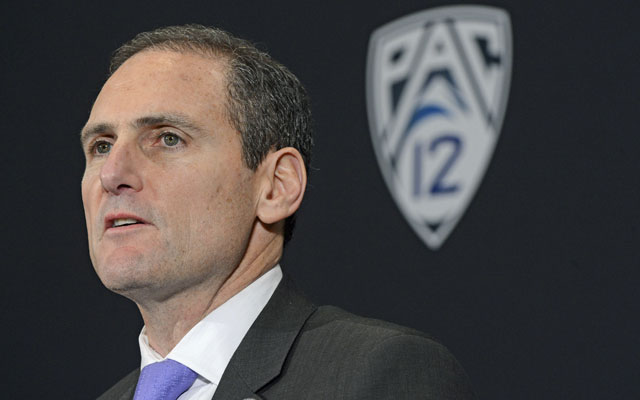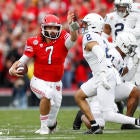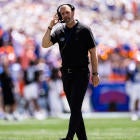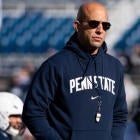
The Pac-12 voted Monday to adopt a reform package that includes guaranteed four-year athletic scholarships, liberalized transfer rules within the conference and post-graduate medical coverage for all athletes.
The changes voted on by Pac-12 presidents and chancellors appear to be the most progressive package put forward by a conference, although they are measures that could have previously been adopted by schools or conferences. The changes come at a time when the Power 5 conferences have the autonomy to vote on and create their own benefits as college sports faces ongoing litigation threats over how athletes are treated and compensated.
“Hopefully this demonstrates to anyone that’s paying attention that reform is possible within a conference, within the NCAA, and that there are schools out there serious about it and will redirect a lot of resources toward it,” Pac-12 commissioner Larry Scott said in an interview with CBSSports.com. “Hopefully this makes clear how serious our schools are for doing as much as possible for student-athletes without crossing the line in terms of professionalism.”
The Pac-12's changes:
• Guaranteed four-year athletic scholarships while in good standing.
A scholarship will not be reduced or canceled if the athlete remains in "good standing and meets his/her terms of the agreement." The Pac-12 said starting in 2015-16 all of its scholarship agreements offered to recruits will be multiyear agreements for no less than four academic years.
Earlier this month, the Big Ten became the first major college conference to guarantee scholarships across all sports through the duration of an athlete's enrollment at a university. The NCAA is now in its third academic year since passing a rule giving schools the option to provide multiyear scholarships
A recent CBSSports.com analysis showed many universities still don't offer multiyear scholarship agreements. For example, within the Pac-12 in 2013-14, Arizona State provided 18 percent of its athletes with multiyear scholarships, Washington was at 2 percent, UCLA was at 1 percent, and Arizona provided no multiyear scholarships.
The Pac-12 four-year scholarship requirement will apply to athletes on partial scholarships. For instance, if an athlete was promised a 25-percent scholarship entering school, he or she could be awarded more in a given year but can’t be awarded less, Scott said.
The Pac-12 will allow “good standing” to be defined by each school’s publicized student conduct and athletic conduct policies.
“What it is clearly saying is there’s been concern out there within the media and otherwise that a scholarship could be taken away by a coach if he or she doesn’t like the way the student-athlete is performing,” Scott said. “The perception and reality have been vastly different. But this is making clear aid cannot be pulled for athletic performance or by the whim of a coach.”
• Return to school for athletes who don't graduate.
Pac-12 athletes will be allowed to return to school to complete their degree. Starting in 2016-17, if a Pac-12 athlete leaves a university in "good standing" and has completed half of his or her degree, the athlete can return and receive "necessary educational expenses" for remaining terms of the scholarship agreement.
The Big Ten previously announced it would make a similar guarantee for athletes to continue pursuing an undergraduate degree if it gets "interrupted for a bona fide reason."
• Enhanced medical support for current and former players.
Starting in 2015-16, Pac-12 schools will be required to provide direct medical expenses for documented athletically related injuries to former players for a period of four years after they leave their team or university.
“This is meant to respond to concerns that have been expressed that student-athletes put their bodies on the line and there's not good enough care for them after school,” Scott said. “This is saying for four years or until a student-athlete is 26 years old, they’ll have medical expenses.”
The Pac-12 chose four years in part because by the age of 26 a former athlete is covered by the Affordable Care Act, Scott said. Pac-12 schools will administer the medical expenses for former athletes based on their own specific procedures and injuries will need to be documented by a university medical official in order for coverage to continue.
“Essentially, all schools have a process they go through when an athlete gets ready to leave school where they document what injuries they occurred while there,” Scott said. “That will be the process by which they then determine what they treat and cover financially over the ensuing four years.”
Scott said he was not comfortable yet providing estimates on what the additional post-college medical expenses will cost Pac-12 universities. "It can be all over the map," he said.
• Liberalized transfer rules within the Pac-12.
The Pac-12 removed the financial-aid penalty that applies to its transfer rule within the conference. Effective immediately, an athlete who transfers within the Pac-12 can receive an athletic scholarship from the second school immediately provided the athlete is eligible to receive the aid.
“We’re not going to have a rule to withhold aid if you transfer within the conference,” Scott said. “They don’t have to worry about any economic hardship.”
This rule does not allow athletes who transfer within the Pac-12 to play immediately. That is an NCAA rule that would have to be changed nationally through the association's new autonomy or shared governance structure.
“We haven’t had in any substantive way those conversations yet,” Scott said of eliminating the NCAA's one-year transfer rule. “But it’s something we believe should be discussed. We are encouraging a national discussion about those transfer rules.”
• Increased athlete representation at Pac-12 meetings
The Pac-12 now has athletes attending conference meetings to discuss policies. Scott said athletes will have “meaningful impact” with their voice. He stopped short of saying Pac-12 athletes will have votes at conference council meetings, where each school is represented by an athletic director, senior administrator and faculty rep for one vote per school.
“I’m not opposed to it at all,” Scott said. “We haven’t yet figured out whether we’ll have a fourth representative per school or add a student-athlete vote. We’re going to look at different models.”
• Will other conferences follow?
The reality of what the Pac-12 passed: These are items conferences or schools could have already passed -- some do apply these changes already to various degrees -- and areas other conferences could act on as well without NCAA legislation. Scott said he suspects other conferences or individual schools will act in different ways.
“We decided we didn’t want to wait and see what others are going to do if we have the ability to do things ourselves,” Scott said. “I think all the things we acted on are things all conferences have been talking about. This was an opportunity to pivot from talk to action and step up.”
The Pac-12 will rely heavily on each of its schools to self-enforce the reform package. “Like with any conference rule, if there’s a concern brought to our attention, we’ll have to the ability to review it and discuss it,” Scott said. “But mostly we’re relying on the schools to self-enforce this.”
The Pac-12 appointed a task force to study the issue of excessive time demands for college athletes and plans to work with the other Power 5 conferences on the topic. Scott noted the issues surrounding time demands are “really, really complicated” that will take a lot of time.
“I met with a group of student-athletes recently and I went around the room and the majority of the room is very leery of the idea of putting demands on them,” Scott said. "These are successful Olympic athletes and others who want to perfect their craft and want the flexibility to put in extra time outside formal practices. We have to tread very carefully about using blunt instruments on this.”




















